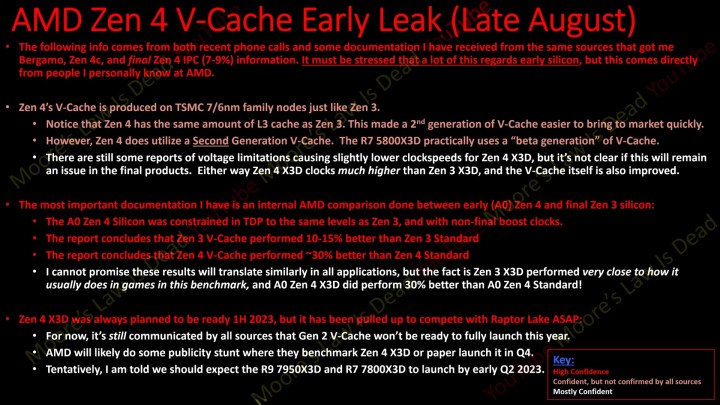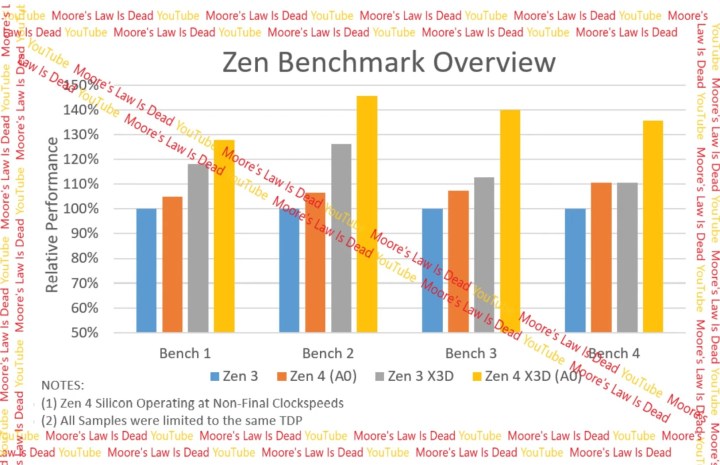AMD is rumored to already have a working Zen 4 3D V-Cache chip, suggesting that it hopes to deal a large blow to Intel sooner than expected. An early sample of the CPU blew its predecessors out of the water in certain benchmarks.
If AMD is accelerating its launch strategy for the successor to the Ryzen 7 5800X3D, should Intel be worried? Today’s leaks indicate the answer is a tentative “yes, it probably should.”

Leaker Moore’s Law Is Dead has just released an in-depth video about the upcoming Ryzen 7000 3D V-Cache chips. AMD itself has confirmed that it will bring back the highly successful tech we already know from the Ryzen 7 5800X3D, but it didn’t say much else.
Now, Moore’s Law Is Dead swoops in with a fresh round of leaks citingAMD sources to back up these claims. As always, it’s best to approach them with a hint of doubt, but it’s also worth noting that the YouTuber does often present accurate information ahead of time. Now, assuming you’ve come prepared with that healthy pinch of skepticism, let’s dive in.
According to the recent video, the 3D V-Cache found on Zen 4 processors will represent the second generation of the tech, and as such, it will bring several improvements in terms of performance. This will help it keep up with the faster on-die L3 cache on the Zen 4 chiplets. Moore’s Law Is Dead always cites several sources with different levels of confidence, but one sentiment seems to echo across these reports — we’re about to see a substantial performance gain.
This seems to be true not just for 3D V-Cache chips, but for Zen 4 as a whole. Based on an internal AMD comparison done with constrained TDP levels, Zen 4 CPUs showed a clear performance lift, and the 3D V-Cache version only brought that up even more. Compared to a basic Zen 4 chip, the 3DV version was up to 30% faster.
The YouTuber was allegedly given some internal AMD benchmarks that compared the Zen 3, Zen 3 X3D, Zen 4 (A0), and Zen 4 X3D (A0) chips to one another. These benchmarks don’t tell us much, but it’s clear that Zen 4 3D has the potential to destroy other chips in some regards — and this includes Intel Raptor Lake.
The 3D V-Cache is a strong ace up AMD’s sleeve

Intel had the upper hand over AMD thanks to being able to release Alder Lake CPUs so much earlier. Introducing DDR5 RAM and PCIe Gen 5.0, those processors proved to be successful, although the flagships (such as the Core i9-12900KS) were really expensive. This gap is about to close. AMD already inched closer when it showed off the true power of the 3D V-Cache earlier this year, and now the manufacturer plans to continue down that same path.
So far, the predicted timeline tells us that AMD will launch the top Ryzen 7000 CPUs on September 27; at the same time, its partners will launch the high-end AM5 motherboards. Intel Raptor Lake will come next, but AMD is unlikely to stay dormant. It will follow up with budget Ryzen CPUs and motherboards, and soon may possibly tease the Zen 4 X3D, which would almost certainly give Intel a run for its money both in terms of raw performance and cost to performance.
Intel Raptor Lake might well outperform Zen 4 this year, or it might not — it’s too early to say one way or the other. But what will Intel do once AMD strikes back with these 3D V-Cache beasts? If they turn out to be as good as they seem, Intel might indeed have reasons to be worried.



